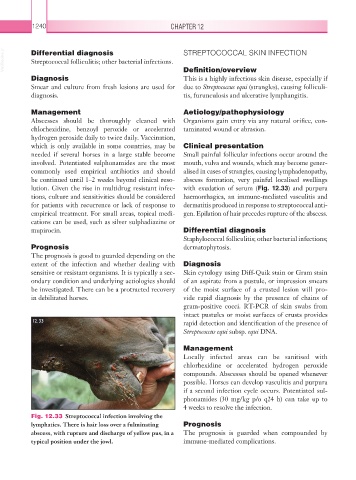Page 1265 - Equine Clinical Medicine, Surgery and Reproduction, 2nd Edition
P. 1265
1240 CHAPTER 12
VetBooks.ir Differential diagnosis STREPTOCOCCAL SKIN INFECTION
Streptococcal folliculitis; other bacterial infections.
Diagnosis Definition/overview
This is a highly infectious skin disease, especially if
Smear and culture from fresh lesions are used for due to Streptococcus equi (strangles), causing folliculi-
diagnosis. tis, furunculosis and ulcerative lymphangitis.
Management Aetiology/pathophysiology
Abscesses should be thoroughly cleaned with Organisms gain entry via any natural orifice, con-
chlorhexidine, benzoyl peroxide or accelerated taminated wound or abrasion.
hydrogen peroxide daily to twice daily. Vaccination,
which is only available in some countries, may be Clinical presentation
needed if several horses in a large stable become Small painful follicular infections occur around the
involved. Potentiated sulphonamides are the most mouth, vulva and wounds, which may become gener-
commonly used empirical antibiotics and should alised in cases of strangles, causing lymphadenopathy,
be continued until 1–2 weeks beyond clinical reso- abscess formation, very painful localised swellings
lution. Given the rise in multidrug resistant infec- with exudation of serum (Fig. 12.33) and purpura
tions, culture and sensitivities should be considered haemorrhagica, an immune-mediated vasculitis and
for patients with recurrence or lack of response to dermatitis produced in response to streptococcal anti-
empirical treatment. For small areas, topical medi- gen. Epilation of hair precedes rupture of the abscess.
cations can be used, such as silver sulphadiazine or
mupirocin. Differential diagnosis
Staphylococcal folliculitis; other bacterial infections;
Prognosis dermatophytosis.
The prognosis is good to guarded depending on the
extent of the infection and whether dealing with Diagnosis
sensitive or resistant organisms. It is typically a sec- Skin cytology using Diff-Quik stain or Gram stain
ondary condition and underlying aetiologies should of an aspirate from a pustule, or impression smears
be investigated. There can be a protracted recovery of the moist surface of a crusted lesion will pro-
in debilitated horses. vide rapid diagnosis by the presence of chains of
gram-positive cocci. RT-PCR of skin swabs from
intact pustules or moist surfaces of crusts provides
12.33 rapid detection and identification of the presence of
Streptococcus equi subsp. equi DNA.
Management
Locally infected areas can be sanitised with
chlorhexidine or accelerated hydrogen peroxide
compounds. Abscesses should be opened whenever
possible. Horses can develop vasculitis and purpura
if a second infection cycle occurs. Potentiated sul-
phonamides (30 mg/kg p/o q24 h) can take up to
4 weeks to resolve the infection.
Fig. 12.33 Streptococcal infection involving the
lymphatics. There is hair loss over a fulminating Prognosis
abscess, with rupture and discharge of yellow pus, in a The prognosis is guarded when compounded by
typical position under the jowl. immune-mediated complications.

